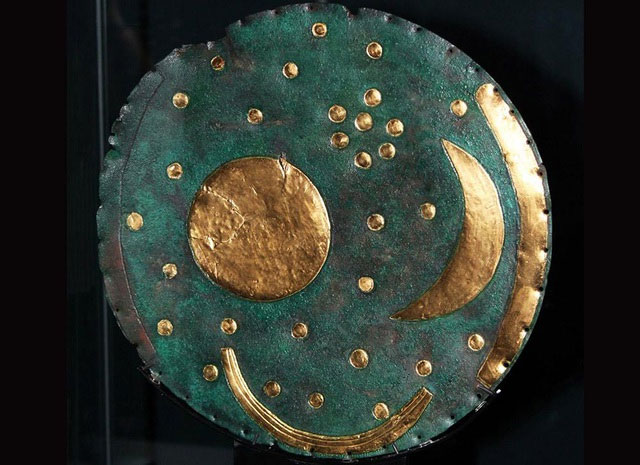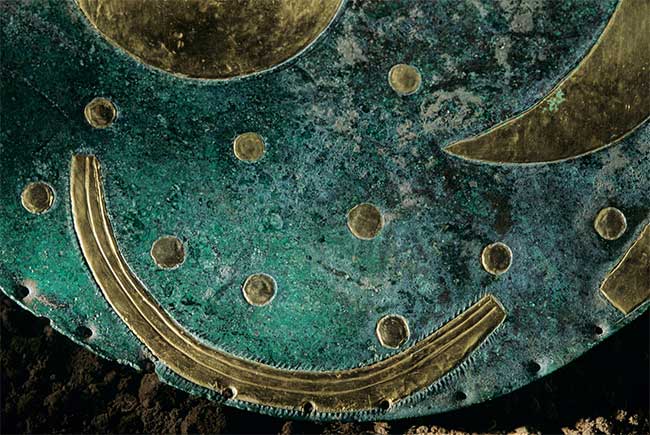Revealing the secret of the age of the Nebra disc depicting the oldest universe
Dating back at least 3,600 years, the Nebra Sky Disk is considered the oldest astronomical map of cosmic phenomena.
The disc is the oldest man-made depiction of the night sky, the Nebra disc was used to measure the angle of the Sun at the poles. Some theories suggest that it was intentionally buried thousands of years ago by ancient Europeans, who had been using the map for about 200 years and even made some changes to hide some stars and add symbols to better accommodate leap months.
Archaeologists from Goethe University Frankfurt and Ludwig-Maximilian University in Munich have now reanalyzed all the data relevant to the reconstruction of the discovery site and the surrounding circumstances of the area where the ancient bronze disc was discovered.
The researchers' findings suggest that the disc must date from the Iron Age , making it around 1,000 years 'younger' than previously thought. This renders all previous interpretations of the Nebra Sky Bronze Disc obsolete.

Nebra Sky Disc.
The Nebra Sky Disc is one of Germany's most important archaeological finds that was included in UNESCO's World Heritage List in 2013. It was discovered during an illegal excavation in 1999 along with Bronze Age swords, axes and bracelets.
In addition, the primitive and uneducated excavation of the antiquities team damaged the outer rim of the disc and caused a piece of the golden arc and one of the stars to be lost. Despite the damage, the Nebra Disc was sold to an illegal antiquities dealer in Switzerland. It was not until 2002 that experts were able to find it.

It was discovered during an illegal excavation in 1999.
The context of this discovery is crucial to the scientific dating of the disc itself, as it cannot be dated scientifically or archaeologically when compared to other objects. Therefore, years of investigation by several research teams have attempted to establish the provenance of the discovery site as well as the general origin of the objects independent of the vague information provided by the looters.
Initially, many people thought that the Nebra disc was an archaeological fake. For example, Richard Harrison, professor of European history at the University of Bristol, once answered in an interview , 'When I first heard about the Nebra disc, I thought it was a joke, at that time I really thought it was a fake. Because it is such an extraordinary work that none of us would be surprised if it was made by some talented blacksmith and sold for a very high price'. Harrison's skepticism at that time was completely reasonable because he had never seen the disc. However, after the disc underwent detailed scientific analysis, it was proven to be genuine and a precious artifact of humanity. In 2013, UNESCO recognized the Nebra disc as a documentary heritage and commented that it was the work "the most specific and oldest description of cosmic phenomena in the world" .

The disc underwent detailed scientific analysis and was proven to be authentic.
The Nebra disc is made of bronze, approximately 30cm in diameter, weighs 2.2kg and has a blue and green patina. It is inlaid with gold symbols depicting the crescent moon, the sun or a full moon and 32 stars (the stars also form a cluster of 7, which is believed to represent the Pleiades). Two gold arcs were added later on the sides of the disc, with an angle of 82 degrees, to accurately represent the position of the sun in summer and winter at the Mittelberg latitude (51°N). A smaller arc at the bottom represents a solar boat with many oars. There are approximately 40 small holes, approximately 3mm in diameter, punched around the rim of the disc, allowing the user to easily attach it to a piece of cloth and carry it outside.
Each symbol on the disc is part of ancient European beliefs. The Sun was worshiped as a sign of life throughout Europe; the Moon was used as a symbol to mark the passage of time. The Sun Boat refers to the European myth that the Sun would be carried away by a boat at night.
The disc also shows that its creators had connections with other cultures across Europe and beyond. The copper used for the disc was mined in Central Europe, while the gold came from Cornwall in England or Transylvania in Romania. The sword and axe designs found on the disc are typical of the Unetice culture , which spanned central Germany through Poland and the Czech Republic. The spiral bracelets are similar to those found in Scandinavia and Ireland. Images of the Pleiades star cluster are also found in ancient cultures from Mesopotamia to Greece.

Each symbol on the disc is part of ancient European beliefs.
Most researchers believe that ancient Europeans used it as an astronomical clock to help them assess the appropriate time (winter or summer) to start planting or harvesting crops. Accordingly, the Pleiades star cluster was a guiding sign for farmers in Mesopotamia and ancient Greece, it appeared in March and disappeared in October. Therefore, farmers in the region often relied on it to conduct planting and raising livestock.
Ancient scholars have been mapping the stars for thousands of years through astronomical structures such as the Goseck Circle and Stonehenge. This shows that people have known about the stars and basic astronomical events such as eclipses . But according to previous discoveries, the earliest recorded images of an actual constellation were not recorded until 1400 BC in Egypt until the discovery of the Nebra disc.

People have known about the stars and basic astronomical events such as solar and lunar eclipses since ancient times.
Despite its popularity and importance, there are still many unanswered questions about the Nebra sky disk. For example:
- Who created it and what is its purpose?
- How is it used and by whom?
- How accurate is it as an astronomical instrument?
- How did it get to the Mittelberg hill?
- Why was it buried and when?
- How has it survived for over 3,000 years without being corroded or destroyed?
However, most experts agree that it is genuine and dates to around 1,600 BC (that is, 3,600 years old) based on scientific analysis of its materials, design, setting, and astronomical features.
If the Nebra disc had been found in Egypt or Greece, where civilization had reached a certain level during the Bronze Age, it might not have been so intriguing. But the disc was found in Northern Europe, which was considered barbaric at the time, with no great cities, no early forms of writing, no signs of philosophy. All that archaeologists had ever found in that region were swords, spears, axes, a fairly primitive society. But the discovery of the Nebra disc made people think completely differently.
According to Harald Meller, director of the State Museum in Halle, which houses the disk, 'The astronomical rules could not have been described without intensive observations over many decades. Until the discovery of the Nebra disk, no one had any idea that the ancients had such precise astronomical knowledge and ability'.
- The oldest solar observatory in the world
- The oldest Western map
- The oldest man in the world organized his 146th birthday
- The oldest man in the world died, aged 112 years
- Detecting huge black holes revealing the universe at the age of cradle
- 'Dissecting' the oldest planet in the universe
- Find the oldest star in the universe
- 'The oldest person in the world' dies at the age of 123 and the secret of a long life is amazing
- NASA captures for the first time 4 objects that travel through space 13.4 billion years, the oldest in the universe
- Discover the oldest stars in the universe?
- The most outstanding cosmic discoveries in 2010
- Radiation detection disc
 The truth about the mysterious red-haired giant at Lovelock Cave
The truth about the mysterious red-haired giant at Lovelock Cave Inunaki Tunnel: The haunted road leading into Japan's 'village of death'
Inunaki Tunnel: The haunted road leading into Japan's 'village of death' The mystery of the phenomenon of human reflection before dying
The mystery of the phenomenon of human reflection before dying 6 mysterious phenomena, although science has been developed for a long time, still cannot be answered
6 mysterious phenomena, although science has been developed for a long time, still cannot be answered